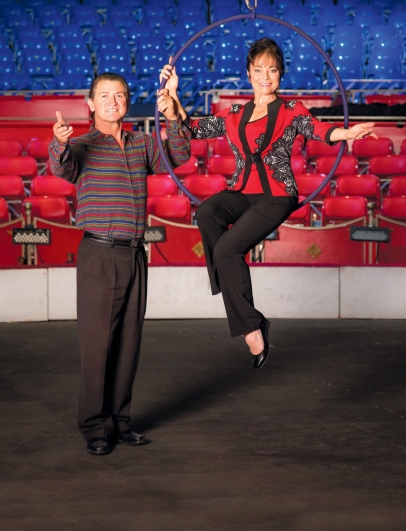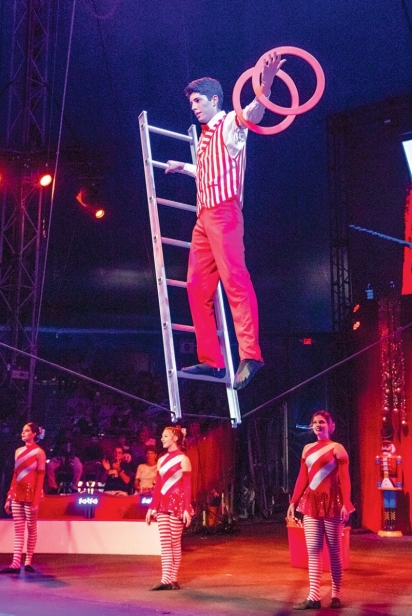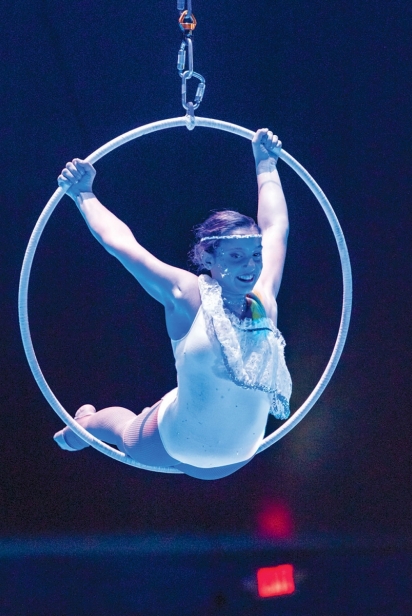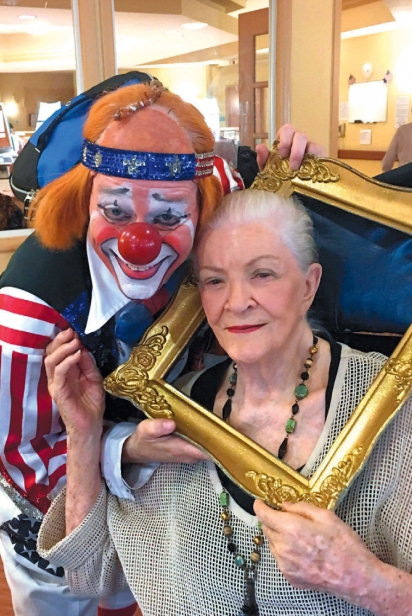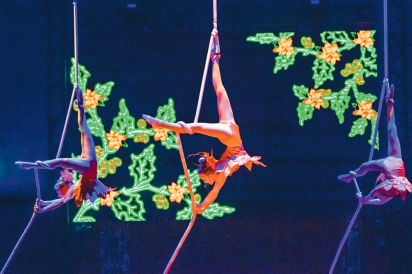How The Circus Came To Town The Circus Arts Conservatory
After an accident left trapeze legend Pedro Reis grounded, he and aerialist Dolly Jacobs— now his wife—created a new circus act, “On the Wings of Love.” Although his “second act” was successful, Reis found himself unfulfilled.
“It really wasn’t my passion,” says Reis. “I’d always wanted to have a professional circus school.”
Realizing his love of circus arts meant the show must go on, the couple again adapted their act, this time shifting toward raising the overall perception of the circus. They wanted it to be recognized as the true art form it is. Sarasota offered the perfect setting.
“The Ringling had left Sarasota County in 1992 and Dolly and I decided to bring back the living circus,” says Reis.
In 1997, in the wagon room of the Ringling Museum, Reis and Jacobs conducted workshop performances. By 1998, they’d invested in a big top of their own.
“We didn’t have any marketing experience,” says Reis. “We didn’t have any budget. We just presented performances and used the income to pay the artists.”
The couple stayed true to their mission, getting out in the community to promote their art, eventually adding outreach programs like Humor Therapy (then called Laughter Unlimited).
“Pedro and Dolly went everywhere to make sure people knew that the circus was vibrant and alive,” says Jennifer Mitchell, chief operating officer of the Circus Arts Conservatory.
But it was a simple program performed at the Pines of Sarasota that Reis considers the turning point for their nonprofit. During the program, some prominent local foundation leaders witnessed firsthand how making balloon animals for patients, residents, and staff provided undeniable results.
“The energy spread like wildfire,” says Reis. “Finally, these foundation gatekeepers understood what we were trying to do, and we started getting funding.”
Today, the Circus Arts Conservatory includes Circus Sarasota, Sailor Circus, Humor Therapy, and Educational Outreach Programs.
“We chose ‘conservatory’ because while we were preserving the heritage of circus, we were also advancing the art forward, making sure it is available for generations to come,” says Mitchell.
Performance
“It is about ‘wow’ factor,” says Reis. “There’s laughter. There’s awe. There’s danger. There’re thrills. There is beauty. There’s grace.”
With an estimated 68–70% return audience, no two Circus Sarasota performances can be the same, and it’s unlikely you’ll see the same artists from year to year. Finding that balance of talent and variety is up to Reis.
“It’s very challenging for me, knowing that I always have to have incredible show,” says Reis. “It’s constantly evolving.”
Now that Circus Sarasota is world renowned, it’s easier to recruit talent or—better yet—for talent to find it. Reis gets thousands of artist links in his inbox and he’s begun discovering talent via a historically unconventional method.
“When you watch something on the computer screen, you’re going to lose about 25% of the energy,” says Reis. “But if you watch an act on YouTube and it absolutely grabs you and you get goosebumps, you know you’ve got to have that act.”
Circus Sarasota performances are intimate, engaging, and focus on one act at time—whether that’s a solitary artist or a troupe. The audience is never more than 50 feet from the performers.
“You’re really seeing what it takes for them to put on their performance,” says Mitchell.
Training
In 2011, Sheriff Tom Knight approached Reis and Jacobs about taking over the Sailor Circus from the Police Athletic League. The youth circus had been in operation since 1949.
“They said, ‘Look, you’re a professional circus organization. You understand training and you’ve always thought about youth development,’” says Mitchell.
Reis and Jacobs agreed that taking on the oldest youth circus in the country made sense. As the daughter of famous Ringling Bros. and Barnum & Bailey Circus clown Lou Jacobs, Dolly was introduced to circus life at young age, learning various acts while training at the Sailor Circus herself before going on to be a professional aerialist. Reis started training on the trapeze at age 12. Both had volunteered for the youth circus. Both were living proof of what circus arts training could provide for community youth.
Born in the Sarasota High School gymnasium and still thriving 70 years later, the Sailor Circus (“The Greatest Little Show on Earth”) is responsible for training thousands, from 8 to 18, in the circus arts and putting on a spring performance. Its training goes way beyond the skills of performing in the arena. Sailor Circus students are taught leadership, teamwork, and even intergenerational communication, reflecting a mix of genders and ages that doesn’t exist in most traditional sports or other activities.
“Although they’re learning how to flip and fly on the trapeze, they are also learning life skills to take out into their careers,” says Mitchell, whose daughter is a Sailor Circus student.
Very few students go on to professional circus careers. In fact, not one of this year’s senior Sailor Circus class plans to go into the circus arts as a professional. But don’t be mistaken: A large portion of those same seniors said they’d written about the circus’s impact in their college essays.
“You drop the juggling club, you pick it up, because the show must continue,” says Reis.
“As an adult, you remember to persevere. Our students learn to keep going, to never give up.”
Outreach
As a nonprofit organization, community outreach is an anchor for the Circus Arts Conservatory.
“We wanted to make sure that whatever we are doing out in the community is at the highest level,” says Reis. “We are true to our mission of giving back.”
The Conservatory is constantly pouring funds back into its outreach programs. Its program known as Humor Therapy, which brings joy and laughter to hospitals, nursing homes, assisted living facilities, and adult care centers, is going on 18 years. Reis estimates 82% of box office revenue is spent on programs that support the community.
Beyond Humor Therapy, the Conservatory serves grades K–12 with various education programs, like its fifth-grade Arts Educated STEAM program for approximately 3,500 students a year in Manatee and Sarasota County schools. The program taps into the physics curriculum, correlating science, technology, engineering, art, and math to circus arts.
“Imagine having circus clowns come in to talk to you about Newton’s laws,” says Mitchell. “Those are memories these children will live with and bring when they have to go back to those scientific concepts later in education.”
Mitchell says that while their aim is not to shy away from the history of what Ringling brought to American circus, they also want to ensure people see the art as deeper than just presenting shows.
“We’re not just here to put up a tent and take it down and move out of town,” she says.
“We’re here to serve the community year-round.”
Legacy
2019 will be “The Year of the Arena” for the Circus Arts Conservatory, and the iconic Sailor Circus Arena is in the closing act of a $4.5 million renovation expected to be unveiled with the spring performances.
“This is one of the most unique buildings in the country and when it reopens, it will be the largest and most preeminent youth training circus building in the country,” says Mitchell.
The renovation includes all-new seating, new bathrooms, level flooring, additional performance space, and—for the first time in 70 years—air conditioning! With all the updates, Reis and Mitchell hope the arena is an ideal space for events and concerts. They already have several facility rentals in the works.
“Now that we have reconstructed the arena, our circus arts program is going to explode,” says Reis.
The updated building will allow more students to train in circus arts and become a medium for fitness for all ages, offering circus arts classes even to adults who, for example, just want to train on weekends.
Ultimately, Mitchell says, the closing of Ringling Brothers and Barnum & Bailey Circus has opened the floodgates for the circus to evolve.
“No longer are we defined by a three-ring show with elephants,” she says. “Now people are really able to see the true artistic expression of circus and that is really exciting to us.”
“What’s amazing for me is when people are leaving the tent,” says Reis. “Every now and again, somebody will come up to me and say, ‘This is my first time and I really regret not going sooner.’”
2019 Performances
February 15–March 10
33 Circus Sarasota performances under the Big Top
March 22 and March 24
Cirque Des Voix, which is a collaboration with the Key Chorale, the 40-piece Cirque Orchestra
April 11–13, April 18–20
Sailor Circus 70th Anniversary Spring Show
For tickets and information on circus arts classes visit circusarts.org
Circus Arts Conservatory Facts
The first Circus Sarasota Big Top performance was in November 1998 on corner of Fruitville and Cattleman Road.
Less than 20% of Sailor Circus members go on to become professional artists.
The Sailor Circus arena is the largest youth circus training facility in the country.
The arena is approximately 60,000 square feet with the height to the truss approximately 40 feet.
The Big Top is approximately 40 meters (131 feet) in diameter. The height of the cupola is 47 feet.


